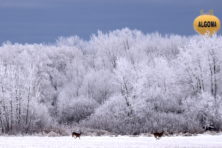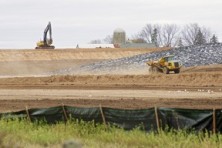Wild Things: DNR Reconsiders, Suggests Split of Door Deer-Management Units
- Share
- Tweet
- Pin
- Share
Jeff Pritzl, the Department of Natural Resources’ (DNR) Northeast District wildlife supervisor, said the wheels are in motion for Door County to be split into multiple deer-management units.
“We know a lot of hunters wanted the split on the table, and now it is,” Pritzl said.
The DNR’s Deer Advisory Committee – a group of state deer specialists and whitetail stakeholder representatives – will consider advancing the recommendations up the chain at its next meeting.
That committee met last week, approving all but five of the state’s County Deer Advisory Committees’ (CDAC) final recommendations to decrease, maintain or increase their respective herds. Split proposals were also on the agenda but were tabled until the next meeting.
Pritzl said any new Door County units would not be in place yet this year, but if approved, they would begin with the 2022 season. The state Natural Resources Board (NRB) is voting only on population objectives later this month, not the splits.
In a letter sent to NRB liaison Laurie Ross as what he called a plea for help and a request for someone to listen, Wisconsin Conservation Congress Door County Chair David Tupa asked that the county be split for the purposes of managing deer, with far fewer antlerless tags available north.
Tupa conveyed a summary of conversations, comments and concerns he’s had or heard from Northern Door residents since the formation of the CDACs and a one-size-fits-all management system beginning in 2014.
The county had previously been managed in up to five deer-management units: 80A, most of the Door mainland north of the canal; 80B, land south of the canal; 80C, Peninsula State Park; 81, most Door islands; and 82, Chambers Island.
Tupa said the former deer-management units were created “using highly educated reasoning and sound scientific data analysis from intelligent DNR game managers.” He believes a rapid decline in the Northern Door deer population began with too many years of earn-a-buck hunts between 2004 and 2008 and continued after the local CDAC voted to give more free antlerless tags than anywhere else in the state – five with each archery or crossbow license, and five more with each license allowing gun deer hunting.
Tupa said that made it look as though there’s an overabundance of deer, attracting visitors to Northern Door’s public lands and further reducing the herd. He’d like to see a buck-only season in Northern Door to promote herd growth, and if not that, then no more than one antlerless tag per license.
Whitetail Seasons End
Through Jan. 29, Door County hunters had racked up 1,689 bucks and 2,397 antlerless deer, for a total of 4,086. Kewaunee County hunters reported 1,311 bucks and 2,247 antlerless, or 3,558 whitetails taken during all seasons.
The 10-day muzzleloader hunt added 89 deer (36 bucks) in Door and 74 (19 bucks) in Kewaunee County (KC). The December four-day antlerless gun hunt saw 95 reported in Door, 81 in KC; and the nine-day holiday antlerless gun hunt 165 in Door, 178 in KC.
The extended bow and crossbow season numbers weren’t final (the hunt ended Jan. 31), but Door stood at 65 (45 with crossbow) and KC at 40 (26 with crossbow). Of those 105 whitetails, 22 were bucks, and 83 were antlerless.
Statewide, the harvest figure was 332,458: 156,765 bucks and 175,693 antlerless. The late hunts produced 7,223 with muzzleloader (2,818 bucks); 8,498 during the four-day antlerless hunt (15 bucks); 5,877 during the holiday hunt (19 bucks); and 1,200-plus during the extended bow and crossbow season (307 bucks).
Whitefish Public Hearing
A preliminary public hearing on a statement of scope that will allow the DNR to begin work on an emergency rule relating to whitefish management on the waters of Green Bay will be held via Zoom on Feb. 8, 6 pm. Interested parties can also join by phone at 312.626.6799 using meeting ID 863 0192 3865#.
Although no specific rule proposals have been developed, the commercial whitefish quota could be increased in Green Bay to take advantage of abundant stocks, and decreased in Lake Michigan to protect certain stocks from overharvest. In addition, electronic reporting could be required of all licensed commercial fishers.
Based on the input, and if the scope statement is approved, the DNR will work with commercial and sport fishers, the Lake Michigan Commercial Fishing Board and the public on an emergency rule.
Rapid Lake Level Decline
Bitter cold will arrive this weekend, but an otherwise mild winter has accelerated the seasonal declines of Great Lakes water levels. Much less ice cover than usual over its 31,700 square miles means increased evaporation on Lake Superior, which feeds the other lakes and contains about 10 percent of the world’s surface fresh water.
In addition, snowfall amounts have been much lighter than normal. If that trend continues, there will be far less runoff this spring.
As of Jan. 29, Lake Michigan was at its lowest level since April 2019, having dropped four inches during the past month alone. Levels were down 10 inches from January 2020, and six inches below the monthly record, set in 1987. Lake Michigan was still 57 inches above the record monthly low, set in 2013.
Great Backyard Bird Count
This year’s Great Backyard Bird Count (birdcount.org) will run Feb. 12-15. Last year, participants in more than 100 countries identified nearly 7,000 of the world’s estimated 10,000 bird species.





